Rachel Dodge's Blog, page 9
October 25, 2021
Martha Lloyd’s Household Book

Martha Lloyd’s Household Book: The Original Manuscript from Jane Austen’s Kitchen by Julienne Gehrer is the book that I’m putting at the top of my wish list this year. I’d like to read the history of Martha Lloyd’s book and look through its recipes, but I’m also curious about other the instructions for other household products, such as varnish for tables and recipes for whitening your stockings!
As many of my readers know, I’ve always been quite taken with Jane Austen and Martha Lloyd’s lifelong friendship, and it’s particularly fascinating to me that Martha was known for her cookery when she lived with the Austen women in Chawton. If you haven’t seen or heard of this book yet, here are some of the highlights.
Book DescriptionPeek through the kitchen window to experience day-to-day life at Chawton Cottage, the home where Jane Austen wrote and published her famous novels.
Martha Lloyd first befriended a young Jane Austen in 1789 and later lived with Jane, her sister Cassandra, and their mother at the cottage in Chawton, Hampshire, where Jane wrote and revised her novels. Eventually, Martha married Jane’s brother Francis Austen, making her an authority on day-to-day life in the Austen family.
Martha Lloyd’s Household Book is a remarkable artifact, a manuscript cookbook featuring recipes and remedies handwritten over thirty years. Austen fans will spot the many connections between Martha’s book and Jane Austen’s writing, including dishes such as white soup from Pride and Prejudice. Readers will also learn the author’s favorite foods, such as toasted cheese and mead. The family, culinary, and literary connections detailed in the introductory chapters of this work give a fascinating perspective on the time and manner in which both women lived.
Passed down through the Austen family, the Household Book offers unprecedented access into the family home. In this first facsimile publication, Martha’s notebook is reproduced in color, accompanied by a complete transcription and detailed annotations.
 Images of Martha Lloyd’s Household Book, Jane Austen’s House Museum.Jane Austen’s Domestic Life
Images of Martha Lloyd’s Household Book, Jane Austen’s House Museum.Jane Austen’s Domestic LifeIn a fascinating article by Julienne Gehrer titled, “How an 18th-Century Cookbook Offers Glimpses of Jane Austen’s Domestic Life,” she shares this:
“Martha Lloyd’s Household Book is one of the few items we have from Jane Austen’s closest friend. As Martha was an integral part of Jane’s life, her recipe book is a highlight of the collection at Jane Austen’s House in Hampshire. It is fitting that the book resides at Chawton Cottage, a place both women called home. Much of what we know about Martha is through Jane’s letters and a few family reminiscences. But if we reread what has been written about Jane Austen we can catch glimpses of Martha Lloyd, who was often a figure in the background or just nearby. Included as a natural preface to Martha’s household book is an extensive biography of Martha Lloyd. Knowing more of Martha’s life leads us to a greater understanding of the deep friendship between Martha and Jane, a friendship that also included Jane’s sister Cassandra.” – Julienne Gehrer, Literary Hub
Gehrer’s article is full of information about Austen’s home and domestic life. I enjoyed reading it very much. You can read the rest of her wonderful article here.
About the authorJulienne Gehrer is an author, journalist and food historian who lectures on Jane Austen and the long eighteenth century. Her articles have appeared in Texas Studies for Literature and Language, Jane Austen’s Regency World, and JASNA News. She is the author of several books including this one and Dining with Jane Austen (2017).


What’s on your wish list this year? What books are you hoping to read before the year ends?
Grace and peace,
Rachel
Subscribe to my blog
for articles on literature, faith, and my writing adventures!
Order signed books here on my web site!
Each autographed book comes with a matching bookmark.
 The Anne Devotional
The Anne Devotional
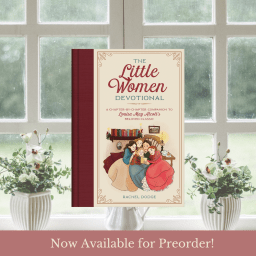 RELEASING DECEMBER 1ST:
RELEASING DECEMBER 1ST:THE LITTLE WOMEN DEVO
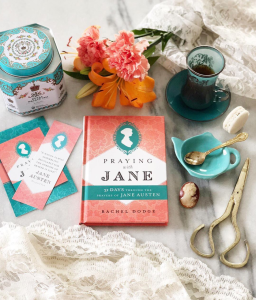 Praying with Jane
Praying with JaneThe post Martha Lloyd’s Household Book appeared first on Rachel Dodge.
October 18, 2021
Anne Shirley’s World of Octobers

Like Anne, I’m so glad to live in a world with Octobers. Can you imagine if we didn’t? As Anne says, “I’m so glad I live in a world where there are Octobers. It would be terrible if we just skipped from September to November, wouldn’t it? Look at these maple branches. Don’t they give you a thrill—several thrills? I’m going to decorate my room with them.” (Anne Shirley, Anne of Green Gables)
With autumn on my mind and Anne Shirley as my inspiration, here are some creative ideas for making your October special, Kindred Spirits!
Bake an Anne Dessert:“There’s so little scope for imagination in cookery. You just have to go by rules. The last time I made a cake I forgot to put the flour in.” -Anne Shirley
It’s finally cool enough to bake where I live, and I’m so excited for baked goods. I’ve tried a few new recipes this past year, and I love to bake tarts and pies.
Work on your cake baking skills!Try your hand at an apple pie or turnoverDon’t forget to check your ingredient list and set a timer!Try a new recipe!The Anne of Green Gables Cookbook, compiled by Kate Macdonald, one of Montgomery’s grandchildren, includes recipes for Diana’s Raspberry Cordial, Marilla’s Plum Pudding, and Anne’s Liniment Cake. It’s a beautiful book with full-color photos of the recipes inside. You can order it here for yourself or a friend. Or enter my giveaway here for a limited time (closes 10/22/21).
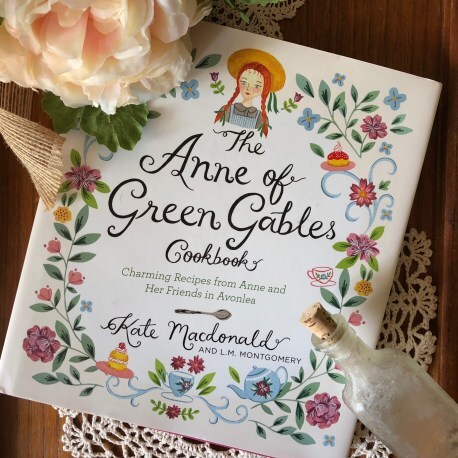
My friend Tammy introduced this blueberry tart recipe to me last year – and it’s divine! I’ve made it at home myself, so I can attest that you do not have to be an expert baker to pull this one off well:
 Half-Baked Harvest: Bursting Blueberry Lemon Thyme TartsRead Anne-ish Books:
Half-Baked Harvest: Bursting Blueberry Lemon Thyme TartsRead Anne-ish Books:“I suppose I must finish up my lessons. I won’t allow myself to open that new book Jane lent me until I’m through. But it’s a terrible temptation, Matthew.” -Anne Shirley
Read Tennyson’s poemsRead Ben Hur !Enjoy a good mystery and get deliciously spookedRead an old-fashioned romanceOr re-read some of the Anne books (or all of them!)To see a collection of beautiful Anne covers, check out this post by Tea & Ink Society. I’ve been collecting the dreamy Tundra covers over the last year. I also have the Starfire classic collection as well, which my daughter has been reading and borrowing from my shelves:

 Enjoy the Fall Foliage:
Enjoy the Fall Foliage:“Diana and I are reading a perfectly magnificent book and there’s a Lover’s Lane in it. So we want to have one, too.” -Anne Shirley
Go on a long walkFind a new trail to exploreRename the lanes and walks near your homeFind your own Lovers LaneWalk by a Lake of Shining WatersGather autumn leaves and foliage to decorate your table at home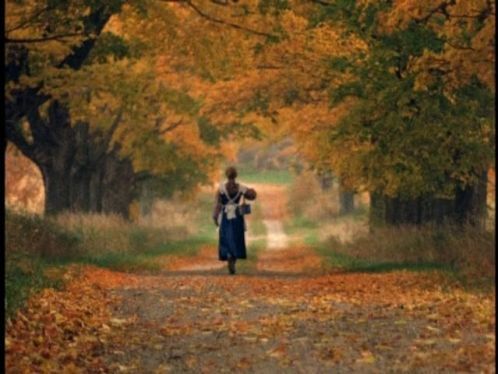 Buy a new dress or sweater:
Buy a new dress or sweater:“Puffed sleeves are so fashionable now. It would give me such a thrill, Marilla, just to wear a dress with puffed sleeves.” -Anne Shirley
Look for a new outfit with puffed sleeves – of course! They are back and better than ever! From sweaters to blouses to dresses, puff sleeves are taking over the world of fashion, and I couldn’t be happier!Don’t go skimpy on material – look for romantic, oversized sleevesFind something that flatters your figureEnjoy the range of fall colors that are popular now: rust, plum, dusty pink, goldenrod, forest green, and wine
 Enjoy the Stage:
Enjoy the Stage:“Of course you must be Elaine, Anne,” said Diana. “I could never have the courage to float down there.”
Go see a play locallyHost a screening of the 1985 Anne of Green Gables film at your houseGather your friends together and recreate the Lily Maid (minus the sinking boat)Read chapters of Anne of Green Gables out loud with a bosom friendWatch Megan Follows’ audition for Anne of Green Gables (Sullivan Entertainment) Host a tea party:
Host a tea party:“Oh, Marilla!” Anne clasped her hands. “How perfectly lovely! You are able to imagine things after all or else you’d never have understood how I’ve longed for that very thing. It will seem so nice and grown-uppish. No fear of my forgetting to put the tea to draw when I have company. Oh, Marilla, can I use the rosebud spray tea set?”
Invite your bosom friend(s) over for a tea party!Make raspberry cordial for refreshmentBake a cake (but don’t forget the flour)Decorate with “an abundances of roses and ferns”Get out your favorite tea set
These are just a few ideas to get your creative juices flowing. What else do you like to do during the Fall to fully enjoy the season?
Grace and peace,
Rachel
Subscribe to my blog
for articles on literature, faith, and my writing adventures!
Order signed books here on my web site!
Each autographed book comes with a matching bookmark.
 COMING DEC 1ST: PRE-ORDER HERE!
COMING DEC 1ST: PRE-ORDER HERE! The Anne Devotional
The Anne Devotional
The post Anne Shirley’s World of Octobers appeared first on Rachel Dodge.
October 12, 2021
Regency Women: Pin Money and Private Expenses

As we investigate the private lives of Regency Women, it’s important to consider money and a woman’s private expenses. If a genteel woman was expected to dress a certain way, do her hair in the latest styles, wear the right shoes and accessories to accentuate her beauty, and care for her own private needs and beauty regimes, how did she pay for everything she needed?
If one of Jane Austen’s heroines (or Jane herself) wanted to purchase something like a bonnet or a ribbon or a new gown, where did she get the money? Who supplied her with money, what was the amount she might have to spend, and how often was it replenished? Let’s find out!
You are very right in supposing how my money would be spent—some of it, at least—my loose cash would certainly be employed in improving my collection of music and books.
Marianne Dashwood, Sense and Sensibility
 Magazine of Female Fashions of London and Paris, No.21. London Dresses, 1799, Wikipedia Commons.Pin Money
Magazine of Female Fashions of London and Paris, No.21. London Dresses, 1799, Wikipedia Commons.Pin MoneyPin money, also sometimes referred to as an allowance, was the money that genteel Regency women used for personal expenses, such as dresses, hats, shoes, and other things of that sort. She kept an accounting of it herself and must balance her own budget.
The history of the term “pin money” dates back to the 1500s: “At that time, pin money was a substantial sum that was used for important purchases. The expression is linked to the price of straight pins, once items that were very rare and expensive, and part of the necessary purchases to run a household” (Grammarist). Over time, the term became synonymous with a woman’s personal money.
For the most part, genteel Regency women were entirely reliant on their male relatives for any “loose cash” for their own personal expenses. As an unmarried woman, she would only have what money her father or a close male relative gave to her (or left to her). Once married, she only had what her husband gave to her or what she was entitled to as part of her marriage settlement.
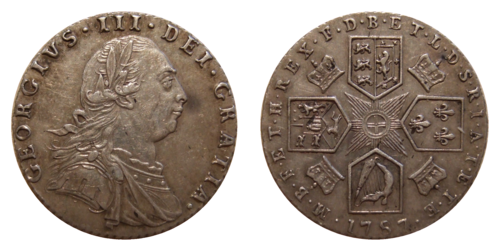 British Sixpence, 1816, Wikipedia Commons.Jane Austen’s Allowance
British Sixpence, 1816, Wikipedia Commons.Jane Austen’s AllowanceWe know that Jane Austen herself had a small allowance from her father. In Oliver MacDonough’s Jane Austen: Real and Imagined Worlds, we read this: “Jane had nothing of her own beyond the pin-money allowed her by her father, which was probably only £20 a year.” Cassandra’s annual allowance, as noted in a letter from 28 December 1798 was twenty pounds: “If you will send my father an account of your Washing & Letter expenses, & c, he will send you a draft for the amount of it, as well as for your next quarter [£5, to be paid on 1 January].”
Mrs. Darcy’s Pin MoneyFinally, Pride and Prejudice shows us how a generous allowance allowed married women to live in comfort, having enough for their own needs and for the needs of others, either for charitable giving or to help support family members.
We can now read Mrs. Bennet’s famous reaction to Elizabeth’s engagement to Mr. Darcy with even more interest:
Oh! my sweetest Lizzy! how rich and how great you will be! What pin-money, what jewels, what carriages you will have! Jane’s is nothing to it – nothing at all.
Mrs. Bennet, Pride and Prejudice
 Jennifer Ehle and Colin Firth, Pride and Prejudice, 1995
Jennifer Ehle and Colin Firth, Pride and Prejudice, 1995And it seems that Mrs. Bennet was correct indeed. We see this play out when Lydia writes to Elizabeth at the end of Pride and Prejudice, hoping to get a regular allowance from Elizabeth and Darcy: “As it happened that Elizabeth had much rather not, she endeavoured in her answer to put an end to every intreaty and expectation of the kind.”
However, while the Darcys do not provide the Wickhams with a regular allowance, Elizabeth still kindly send gifts of money on a frequent basis to help Lydia. She gives this money out of her own private funds, which as the text implies, was substantial:
The Love of MoneySuch relief, however, as it was in her power to afford, by the practice of what might be called economy in her own private expenses, she frequently sent them. . . and whenever [the Wickhams] changed their quarters, either Jane or herself were sure of being applied to for some little assistance towards discharging their bills.
Pride and Prejudice, Jane Austen
Money mattered greatly in the lives of Jane Austen’s Regency women. Having “loose cash” didn’t just provide for bonnets and gowns; it also provided for the safety and protection of several of Austen’s female characters. Money could be used as a means of control or generosity. It could limit a woman or give her greater freedom.
Join me again next month as we delve further into Regency Women: Money Matters and look closely at several instances where Austen uses a lady’s personal money (or lack thereof) as a clever plot device.
RACHEL DODGE teaches college English classes, gives talks at libraries, teas, and book clubs, and writes for Jane Austen’s World blog and Jane Austen’s Regency World magazine. She is the bestselling author of The Anne of Green Gables Devotional: A Chapter-By-Chapter Companion for Kindred Spirits and Praying with Jane: 31 Days Through the Prayers of Jane Austen. Her newest book The Little Women Devotional is now available for pre-order and releases December 2021. You can visit Rachel online at www.RachelDodge.com.
The post Regency Women: Pin Money and Private Expenses appeared first on Rachel Dodge.
October 4, 2021
An Invitation to Sit

What keeps you from sitting down with Jesus? Time, distractions, work, social media, or family members?? Let’s chat about some ways to add JOY to your personal devotions. One of the best way to do that is to think about your environment, with the intention of making your quiet time spot inviting. It should be a place you like to visit!
My favorite quiet time spot is a cozy chair with a blanket and my dog. Get this: I used to read in my closet in the morning with a book light before my children woke up. (Mamas have to be stealthy in the morning!) Sitting propped up in bed with pillows works great as well, but it’s not always feasible. There’s something special about a cozy corner that’s just for me and Jesus.
 INVITATION TO SIT: CHOOSE YOUR SPOT
INVITATION TO SIT: CHOOSE YOUR SPOTChoose a spot without a lot of distractions: This may sound obvious, but having a designated space that is quiet, tucked away, or at least set apart makes a difference. Some ideas for you:
Bedroom corner with a chair or beanbagLiving room chair with lampPrayer closet (with a small stool, you can sit on the floor and use the stool for your Bible and journal)Outdoors (as weather permits)Kitchen tablePropped up in bed with pillowsAnywhere with a pretty view TAKE NOTE: UNBURDEN YOUR HEART
TAKE NOTE: UNBURDEN YOUR HEARTSet out a notebook and a pen to have with you. Even if you’re not a journaling kind of person, you will LOVE keeping track of a few bullet points each day. I like to jot down a quick list of my prayer topics for the day. I pray as I write. It feels good to get things down on paper and out of my head. I also like looking back to see God’s answered prayers.
My prayer journal has a lot of different things in it, including prayers that I write out so I don’t get distracted, but I also do a bulleted list quite often. It doesn’t have to be fancy. I often write down, “Lord, I’m lifting up to you:” and then I put bullet points below with names and items that are on my heart that day.
As you write things down, you will feel less burdened because you’re no longer carrying those things alone and have actively lifted them into Jesus’ hands.
 THE TO-DO LIST NOTEPAD
THE TO-DO LIST NOTEPADMake sure you have a separate note pad close at hand: This is really helpful for cutting down distraction. Whenever you think of a “to-do” for the day that you’re afraid you’ll forget, jot it down on the separate pad. I’ve found that my “to-do” list is often also my prayer list.
Don’t feel as though your deadlines, chores, phone calls, email messages, errands, and doctor’s appointments for the day aren’t part of your time with Jesus. He’s interested in all of it. Ask Him to order your day and help you with any sticky issues or stressful list items.
Each time you stop your Bible reading or prayer time to jot something down, pray over it, lift it up to Him, and keep going. It’s all part of your quiet time.
 Bliss CollectionLET THE LIGHT IN
Bliss CollectionLET THE LIGHT INLighting is a big part of setting up your quiet time space. This will help set the mood, but it will also help you see well and stay awake! Answer a few questions for yourself and try a few things:
Do you like natural lighting?Do you prefer bright, overhead light?Do you like the softer lighting of a lamp?Do you enjoy reading with a book light in the dark? SELECT YOUR BIBLE
SELECT YOUR BIBLEFinding a Bible translation and a Bible that fits your needs is important. For the Bible translation, find one that is readable and accessible for you personally. Don’t read one that’s really hard to read if it will discourage you from reading. Some people enjoy reading one translation for their personal devotions and another for Bible study. Here are a few tips for selecting a Bible or plan:
Take note: There are many Bible now that have a journaling area built in. I personally write ALL OVER my devotional Bible. I buy a new paperback copy of the One Year Bible every few years and scribble all over it. Do what works for you! If you don’t like the idea of writing in your Bible, that’s okay. You can jot down specific verses and personal application in your journal. Either way, write things down and make the verses personal.Make a plan: I personally read the One Year Bible because it helps me to open my Bible and know right where to read each day. Some years I read all of each daily entry. Other years, I focus on the Old or New Testament. The plan you use doesn’t matter – just make sure you have a clear plan.Electronic options: Many people now read the Bible on their phones, tablets, or laptops. There is nothing wrong with that if it works for you. Just make sure that you can truly concentrate and not get distracted. I personally cannot allow myself any electronics nearby. I need to tangibly hold God’s Word in my hands and jot down notes in the margins or in my journal. It’s a tactile thing that really helps me connect. MAKE IT COZY
MAKE IT COZYThis where you add your own personal touch to your quiet time space to make it inviting and happy. Your quiet time spot should be a place that’s special and is attached to many sweet memories with Jesus. Some ideas for making your spot your own:
Add a blanket that’s cozy and prettyLight a candle or turn on a lampMake a cup of tea or coffeeCuddle up with a favorite petPrepare a light snack if neededSelect a new notebook, pen, or BiblePlay soft music (if you don’t find it distracting) YOUR JESUS APPOINTMENT
YOUR JESUS APPOINTMENTFinally, choose the time of day that works best for you and can be consistent. Many people like to start the day with Bible read and prayer, but if you’re not a morning person, work on finding a time that works well for you. Others know they will fall asleep if they try to have a quiet time in the evening, but they feel most alert in the morning. There’s no wrong time of day for your devotions. Times of day to try and consider:
Early morning before the house wakes up (this is for the early birds)At the breakfast table (before or after other household members eat)On a morning break or on your lunch break at school or workAfter dinnerBefore going to bed (this is for the night owls)Outdoors after a morning walk
Whatever you do, make your quiet time spot a special place. It should be the place where you can retreat from the world, gather your thoughts, and spend time with the God who loves you. Do what it takes to make sure that your personal devotions are refreshing and enjoyable.
Do you have a special quiet time spot? If so, please tell me about it in the comments below! If you have any other tips to add, please share them as well.
Grace and peace,
Rachel
“Come to me, all you who are weary and burdened, and I will give you rest. Take my yoke upon you and learn from me, for I am gentle and humble in heart, and you will find rest for your souls.”
Matthew 11:28-30 (NIV)
The post An Invitation to Sit appeared first on Rachel Dodge.
September 27, 2021
Anne’s School Days by Kallie George

This early-reader series of Anne of Green Gables chapter books by Kallie George is quickly becoming one of my favorite collections in my L.M. Montgomery bookcase. Yes, that’s right. I have one bookcase devoted to Anne of Green Gables, Emily of New Moon, The Blue Castle, and all the rest of Montgomery’s beautiful novels!
I waited for the newest installment, Anne’s School Days, ever since it was announced last year. And it did not disappoint. This is yet another sweet mini-story about Anne’s experiences at school, complete with beautiful illustrations by Abigail Halpin, and a storyline that will intrigue young readers. This time, we get to meet Gilbert Blythe and the rest of Avonlea school!
 Book Description
Book DescriptionAnne’s School Days is the third book in an early-reader series inspired by Anne of Green Gables, starring the spirited Anne Shirley as she navigates her first days of school and the incorrigible Gilbert Blythe.
Anne loves autumn in Avonlea, and she’s been enjoying her first three weeks of school. It helps that she walks to school with and sits next to her kindred spirit, Diana Barry. However, one day, Gilbert Blythe joins the class. According to Diana, he’s very handsome, and smart too. However, Gilbert immediately gets on Anne’s nerves. When he pulls on Anne’s braid and calls her “Carrots” because of her red hair, enough is enough. How can Anne enjoy school when Gilbert is ruining everything? Anne vows never to talk to Gilbert again, and even stops going to school for a time when her teacher forces Anne to sit next to her rival. But later, when Anne has an accident on the pond and her wooden plank sinks, who should come to her rescue but her nemesis, Gilbert Blythe?
Lovingly adapted by Kallie George with beautiful nostalgic illustrations by Abigail Halpin, this series is perfect for fans of Anne, new and old.
Order Anne’s School Days: Order Your Copy HereAbout the Author
Order Your Copy HereAbout the AuthorKALLIE GEORGE is an author, editor and creative writing teacher. She has written numerous books for early readers, including Anne Arrives (book 1), Anne’s Kindred Spirits (book 2), The Magical Animal Adoption Agency series, The Heartwood Hotel series and The Wings of Olympus series, as well as numerous picture books, such as Goodnight, Anne, If I Couldn’t Be Anne, Secrets I Know and The Lost Gift.

Kallie received her Masters of Children’s Literature from the University of British Columbia. She loves picture books, fairy tales, beautiful art and music, and baking cookies. Kallie currently lives in Vancouver, BC, and feels positively certain she and Anne Shirley are kindred spirits. You can follow her online here.
Let’s keep in touch:Subscribe to my blog
for articles on literature, faith, and my writing adventures!
Order signed books here on my web site!
Each autographed book comes with a matching bookmark.
 PRE-ORDER THE LITTLE WOMEN DEVO
PRE-ORDER THE LITTLE WOMEN DEVO The Anne Devotional
The Anne Devotional Praying with Jane
Praying with JaneThe post Anne’s School Days by Kallie George appeared first on Rachel Dodge.
September 20, 2021
“Privy” Matters: Regency Feminine Hygiene, Bodily Functions, and Childbirth

After my previous article on Regency Women: Beauty Behind the Scenes, I realized that the things I really want to know more about concerning Jane Austen’s Regency women aren’t (and weren’t) discussed as much as other topics such as beauty regimes.
I wanted to know about bodily functions (where in the world did a lady relieve herself if she was, say, at a ball?), feminine hygiene (what did women do during “that time of the month?”), and pregnancy and birth (why did so many women die as a result of childbirth?).
Finding this information wasn’t as easy as some of the other information I’ve researched over the years. Why? Because some of these topics (such as menstruation) weren’t discussed openly or written about during Jane Austen’s time. Scholarly authors and bloggers even sometimes make the joke, “maybe women didn’t menstruate back then!”
 Mrs. Jennings and Mrs. Palmer, Sense and Sensibility
Mrs. Jennings and Mrs. Palmer, Sense and SensibilityI can’t help wishing they had not travelled quite so fast, nor made such a long journey of it, for they came all round by London upon account of some business, for you know (nodding significantly and pointing to her daughter) it was wrong in her situation. I wanted her to stay at home and rest this morning, but she would come with us; she longed so much to see you all!”
Mrs. Palmer laughed, and said it would not do her any harm.
“She expects to be confined in February,” continued Mrs. Jennings.
Lady Middleton could no longer endure such a conversation, and therefore exerted herself to ask Mr. Palmer if there was any news in the paper.
Sense and Sensibility, Jane Austen (emphasis mine)
Regency women had specific needs, just as women do now, but information about those needs was shared more discreetly. Women passed information, supplies, and advice to one another—from mother to daughter, sister to sister, cousin to cousin, and even friend to friend. Additionally, terms and nicknames were used for certain topics, such as “in that way” (pregnant); “lying-in” or “confinement” (nearing her due date); and “brought to bed” (gave birth). We can imagine that in some families, young women were informed about such topics without much or any discussion; in others, perhaps a bit more instruction was provided. (Certainly, Mrs. Jennings and Mrs. Palmer seem to have no problem with it!)
In attempt to shed some light on these topics, the following is an overview of each, along with a few resources that go into greater detail. As always, I heartily encourage you to comment with other resources that can help provide more information on these “privy” matters (pun intended).
Bodily FunctionsAt home, chamber pots were frequently used and kept under the bed, out of sight, and emptied and cleaned by a servant. A privy or outhouse was outside the home, away from the house. Many times, flowers were planted near the outhouse to help cover the odor. For an in-depth history of Regency plumbing, you can read this wonderful article from The Jane Austen Centre on The Development of Regency Plumbing.
But what about when a lady was traveling or at a ball? As some of you may already know, a fully dressed lady could (carefully) relieve herself using a small chamber pot called a bourdaloue (or bourdalou) without soiling her skirts. Her maid would stand nearby to help and/or receive the pot and empty it. (Note: Men were known to relieve themselves behind a screen into a chamber pot in the dining room.) For more on this strangely intriguing topic, you can read Vic’s engaging article, Regency Hygiene: The Bourdaloue.
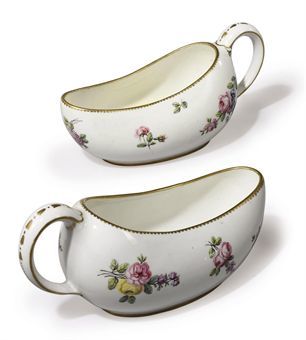 Ladies Bourdaloue, a personal chamber pot.Feminine hygiene and sanitary items
Ladies Bourdaloue, a personal chamber pot.Feminine hygiene and sanitary itemsAnd what, pray tell, did a lady to do when menstruating? In her article “On ‘Flowers’: A short but frank post on how 18thC women dealt with menstruation,” Lucy Inglis has several interesting tidbits to share: Early sanitary pads were used by women in Georgian England, made from a variety of materials. “Women troubled by particularly heavy periods wrapped a belt or bandage about their hips and wore a baby’s muslin napkin looped over the front and back, with stitched ‘sanitary pads’ lining this loincloth. These pads could be boiled and reused…”
As for tampons, this was surprisingly not unheard of. Early handbooks discuss “‘suppositories’ for the ‘privy place’ made from a smoothed stick, wrapped in absorbent linen rags and securely stitched. A long cord was sewn in. Some disposable; some boiled and reused” (Inglis). For menstrual cramps and other issues, herbal remedies were often used. For more on this topic and others like it, check out Inglis’ book Georgian London: Into the Streets.
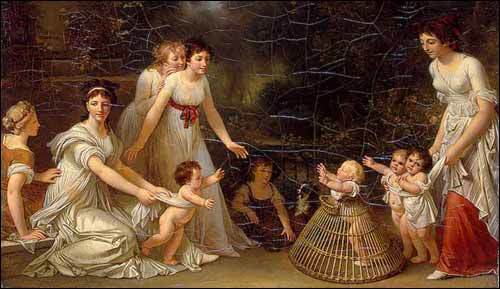 Regency families were often large to account for high child mortality rates.Pregnancy and childbirth
Regency families were often large to account for high child mortality rates.Pregnancy and childbirthDuring the Regency era, childbirth was still one of the most dangerous threats to a woman’s health and life. Up to 20% of all women died either in childbirth, or immediately following birth, most often due to infection. (Many accounts place the infant mortality rate at about the same level.) The practice of washing hands, disinfecting instruments, and providing clean linens and ventilation in birthing chambers did not become common until about the 1840s, which then lowered the mortality rate from 18% to about 6% (Jane Austen Centre). To read an in-depth discussion of birth, birthing rooms, and advances in obstetrics, read here: “Developements in Childbirth in Regency and Victorian England: Childbirth and Lying-In during the Regency” by Kathleen Charon.
Some of the issues that plagued new mothers and babies were due to limited medical practices and a lack of simple hygiene, but there were other factors at play as well. For instance, instead of having women move, walk, and get a breath fresh air, a “lying-in” or “confinement” period was observed before, during, and even after giving birth.
During the birth, a midwife would likely be in attendance; in some instances, a doctor might come. The birthing room was heated and enclosed so that women would not catch cold; however, the stifling rooms often caused a host of other issues, including an increase in infection. After giving birth, women were kept in bed, often given only weak tea and a liquid diet, instead of hearty, nourishing foods to help her heal and gain strength.
I have just received a note from James to say that Mary was brought to bed last night, at eleven o’clock, of a fine little boy, and that everything is going on very well. My mother had desired to know nothing of it before it should be all over, and we were clever enough to prevent her having any suspicion of it…
Jane Austen’s Letters, Godmersham Park, 17 November 1798.
 Queen Charlotte, King George IIIs consort, gave birth to 15 children in 21 years. These are their 6 eldest.
Queen Charlotte, King George IIIs consort, gave birth to 15 children in 21 years. These are their 6 eldest.Indeed, life for women in Jane Austen’s Regency England, even as part of the upper classes, was uncomfortable, difficult, and dangerous. When I think of my own birth, and the births of my two children, by caesarean section, with the help modern medicine, I stand amazed at the bravery of the women who came before me. To say I’m thankful for the miraculous advances in medicine and obstetrics today would be an understatement.
This, I’m sure, is only the tip of the iceberg with these topics. If you have other resources to share, such as books, articles, podcasts, or talks, please include them in the comments!
This article originally appeared on Jane Austen’s World blog.
RACHEL DODGE teaches college English classes, gives talks at libraries, teas, and book clubs, and writes for Jane Austen’s World blog and Jane Austen’s Regency World magazine. She is the bestselling author of The Anne of Green Gables Devotional: A Chapter-By-Chapter Companion for Kindred Spirits and Praying with Jane: 31 Days Through the Prayers of Jane Austen. Her newest book The Little Women Devotional is now available for pre-order and releases December 2021. You can visit Rachel online at www.RachelDodge.com.
The post “Privy” Matters: Regency Feminine Hygiene, Bodily Functions, and Childbirth appeared first on Rachel Dodge.
September 13, 2021
DEVOTIONAL BOOK GIVEAWAY!

Happy Almost-Fall to you, Kindred Spirits!
This is the time of year when we can all use a little inspiration to get back into gear with our quiet times and spiritual lives. To get us all in the mood for cozy fall vibes, I’m giving away ONE (1) copy of ONE (1) of my devotional books!
BOOK PRIZE:Your Choice: The winner of this giveaway gets to choose ONE (1) copy of Praying with Jane: 31 Days Through the Prayers of Jane Austen OR ONE (1) copy The Anne of Green Gables Devotional: A Chapter-by-Chapter Companion for Kindred Spirits.
If you’ve been wanting to dig deeper into your faith or find a creative way to develop your personal devotions, these devotional books are a great way to unite your love for Jesus and your love for the classics to inspire you to get into God’s Word each day.
HOW TO ENTER:To enter the giveaway, please leave your answer to this question in the comment section: If you could have tea with Jane Austen or Lucy Maud Montgomery, who would you choose and why?⠀
GIVEAWAY RULES:⠀⠀⠀Must be a current subscriber to my blogMust leave a comment on this post answering the above questionGiveaway ends Monday 9/20 at 11:59 p.m. PTPhoto by my lovely friend Courtney @healingchapters!!
Let’s keep in touch:Subscribe to my blog
for articles on literature, faith, and my writing adventures!
Order signed books here on my web site!
Each autographed book comes with a matching bookmark.
 The Anne Devotional
The Anne Devotional
 Praying with Jane
Praying with Jane
 PRE-ORDER THE LITTLE WOMEN DEVO
PRE-ORDER THE LITTLE WOMEN DEVOThe post DEVOTIONAL BOOK GIVEAWAY! appeared first on Rachel Dodge.
September 1, 2021
Blessings in the Wilderness

Do you ever feel like you’re wandering in the wilderness? Wilderness seasons can be difficult, draining, and discouraging. There’s a lot of wondering and waiting. And though the Lord always provides our manna in the wilderness, sometimes we begin to grumble and tire of it.
But God never said He would take us directly from difficulty straight into blessing. And just as God didn’t take the Israelites out of Egypt and immediately into the Promised Land, we too have a journey to make and a path to walk on the way to our Heavenly Promised Land.
Only in the WildernessBefore they got to the Promised Land, the Israelites had to walk through the wilderness first. But here’s the great and encouraging news: God gave the Israelites specific blessings, experiences, and instructions IN the wilderness that could only be obtained IN the wilderness. And He wants to do the same for me and you!
As you read this list, ask God to speak to your heart in a personal way. Ask Him to show you the wilderness blessings He’s providing right now.
Gave gave the Israelites a pillar of fire by night and a cloud by day to direct them. (Neh. 9:12; 19)God protected them and provided for them. (Neh. 9:19-20)God gave them streams and pools in the desert for their thirst and brought water from a rock. (Neh. 9:15)He gave them manna for their hunger and it was always enough. (Neh. 9:15)He taught them to rest one day each week for their weariness. (Neh. 9:14)He cared for their physical needs and didn’t let their clothes or shoes wear out. (Neh. 9:21)He cared for their community and gave them the 10 Commandments and the Law. (Neh. 9:13-14)He cared for their spiritual needs and taught them how to build the tabernacle and how to worship. (Exodus 25-30)He gave them His presence and “His good Spirit to instruct them.” (Neh. 9:20)A History of FaithfulnessNehemiah 9:12-15 and v. 19-21 provide for us a timely summary and reminder of God’s faithfulness. As you read these verses, allow the Holy Spirit to stir your heart to remember God’s mighty works in your life:
11 You divided the sea for your people so they could walk through on dry land! And then you hurled their enemies into the depths of the sea. They sank like stones beneath the mighty waters. 12 You led our ancestors by a pillar of cloud during the day and a pillar of fire at night so that they could find their way.
13 “You came down at Mount Sinai and spoke to them from heaven. You gave them regulations and instructions that were just, and decrees and commands that were good. 14 You instructed them concerning your holy Sabbath. And you commanded them, through Moses your servant, to obey all your commands, decrees, and instructions.
15 “You gave them bread from heaven when they were hungry and water from the rock when they were thirsty. You commanded them to go and take possession of the land you had sworn to give them.
19 “But in your great mercy you did not abandon them to die in the wilderness. The pillar of cloud still led them forward by day, and the pillar of fire showed them the way through the night. 20 You sent your good Spirit to instruct them, and you did not stop giving them manna from heaven or water for their thirst. 21 For forty years you sustained them in the wilderness, and they lacked nothing. Their clothes did not wear out, and their feet did not swell!
On the WayGod didn’t give the Israelites all of that provision and help when they finally arrived in the Promised Land… No, He gave those things to them on the Way.
There is so much the Lord does in our hearts and lives “on the way” — as we follow Jesus, help make disciples, and look forward to Heaven, our Promised Land.
This reminder has encouraged me so much this past month. It gives me hope and an excitement to see what all God wants to teach me and show me in the wilderness. I pray it encourages you as well!
Grace and peace,
Rachel
“During the forty years that I led you through the wilderness, your clothes did not wear out, nor did the sandals on your feet.”
Deuteronomy 29:5 NIV
Subscribe to my blog
for articles on literature, faith, and my writing adventures!
Order signed books here on my web site!
Each autographed book comes with a matching bookmark.
 The Anne Devotional
The Anne Devotional PRE-ORDER THE LITTLE WOMEN DEVO
PRE-ORDER THE LITTLE WOMEN DEVO Praying with Jane
Praying with JaneThe post Blessings in the Wilderness appeared first on Rachel Dodge.
August 23, 2021
Kindred Verse: Poems Inspired by Anne of Green Gables
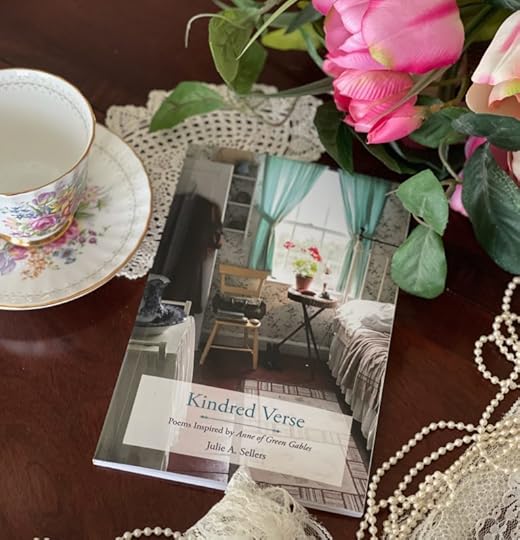
If you love Anne of Green Gables, I’m here to report that Kindred Verse: Poems Inspired by Anne of Green Gables by Julie A. Sellers is an absolute must-have for your bookshelves, Kindred Spirits!!
This books takes the dreamy, nostalgic world of Anne of Green Gables and puts it into poem form. If you’re not a poetry fan, I promise that this book will grab your attention immediately. The poems are tender, lovely, and readable. It’s a gentle read that will soothe your soul.
As I read through this book, I was touched by Julie Sellers’ ability to capture that ache that I and so many others feel when we think of Anne Shirley and her beautiful island. Her poems will transport you to Anne’s world…and to that place in your own imagination that’s inhabited by Anne Shirley, Diana Barry, Marilla and Matthew Cuthbert, and all of Avonlea!
I was over the moon excited when Julie agree to do a Q&A for my blog readers! You are in for a real treat, as you will see from our conversation below. Not only is Julie a talented writer, she is also a Kindred Spirit!
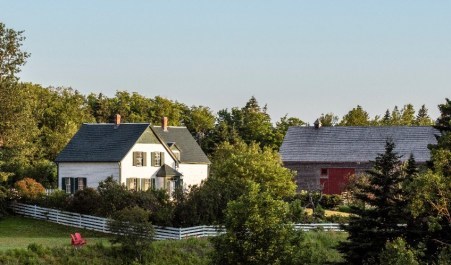 Green Gables Heritage PaceAuthor Q&A
Green Gables Heritage PaceAuthor Q&AQ. What are your earliest memories of Anne of Green Gables and how has that novel impacted your life?
I first read Anne of Green Gables when I was fourteen. Across the years, Anne has always felt like home to me, a place I can return to because I love it or need it. She’s modeled what it means to be creative, to dream, and the importance of self-respect. Anne’s indomitable personality has encouraged me to continue to pursue goals when I might otherwise have given up. One of my favorite characters from Anne of Windy Poplars was Katherine Brooke. I could empathize with her dreams of travel, and books were the only way I travelled much until I was in college. Like Katherine, I wanted to know for myself that the world was round, and that influenced my decision of studying world languages. I always imagined Anne would have told me to chase that dream and others, just as she encouraged Katherine to live her truest life.
Q. What was your inspiration for the book Kindred Verse? How long did it take to write the poems in it?
Kindred Verse kind of happened by accident. I had written one poem, “A Home for Imperfect Girls,” to enter a contest. The theme of the contest was fernweh (farsickness), meaning a longing for distant places, whether you’ve ever been there or not. I thought it was an interesting concept, and the first place that came to mind to write about was Green Gables. At that time (summer 2019), I had challenged myself to write a poem each day, and once I had Anne of Green Gables in mind, different aspects of the novel kept popping into my head. I didn’t win the contest, but I did get a small stack of Anne-related poems.
It was only then that the inspiration to write a collection occurred to me. I wrote some poems here and others there and collected them. In October 2020, I was at a virtual read-around to kick off the Kansas Author’s Club’s annual convention. The owners of Blue Cedar Press heard me read one of my Anne poems, “Windows.” They asked me if I was working on anything book-length, and I pitched my idea for my collection of poetry accompanied by photographs. The press’s board unanimously voted to publish my book. We began working with Jay Wallace, a design professor and colleague of mine at the college where I teach, on the layout and design in January 2021, and the official launch was June 15, 2021.
Q. What is one of your favorite poems in this collection?
Choosing a favorite poem is a challenge. Each one brings a memory to me from Anne of Green Gables and my own life experiences in relationship to the novel. I enjoy “A Home for Imperfect Girls” because I think it speaks to how many around the globe have related to Anne. I also really like “Dreamroom” because it combines the nostalgic hues that tint so much of Montgomery’s work with the idea that words and places always continue to exist in our imagination. I also really like the photo of Montgomery’s typewriter that accompanies that poem. I’ve already heard from a number of people all around the globe who tell me they love “Kindred Spirits,” and I think that speaks to the enduring legacy of Montgomery’s work to join us together.
Q. In what ways do you relate to Anne Shirley or the other characters in the novel?
I’ve always found I had a lot in common with Anne Shirley. When I first read the novel, I was an imaginative, creative girl who loved to read and dreamed of being a writer. I could get lost in the beauty of nature and words and lose all track of time, much to my practical, Midwestern family’s chagrin. I also seemed to have a similar uncanny knack for getting into scrapes—and I still do! When I first read Anne, I felt as if I had opened a book and discovered a reflection of myself in those pages. Avonlea and the unique characters that populated it reminded me of so many people I knew in the small-town, rural community where I grew up. As a writer, I also loved the Emily series, but my second-favorite Montgomery novel has always been The Blue Castle. As the youngest on one side of my family, I could relate to being compared to an older sibling and cousins. Valancy’s love of nature and her walks through the woods also struck a chord with me, since I felt and did the same.
Q. Have you visited Prince Edward Island? (If so, what were your favorite spots to visit? If not, what are the first few stops you would make if you went?)
I have had the good fortune to visit Prince Edward Island twice, once in 2006 for my honeymoon (and it was my husband’s idea, so he earns an A+ in the Gilbert category), and again in 2018 to attend and present at a conference on L.M. Montgomery and Reading. I’ve loved visiting all the Anne- and Montgomery-related locations, but my favorite part of going to PEI has been soaking in the beauty of the landscape. The contrasts between the red roads and sands, the green grass and fields, and the blue sea are breathtaking. Montgomery loved nature, and it inspired her. It’s clear to see why when you walk the shores or wander down wooded paths of her Island home, looking for bends in the road.
This collection of beautiful, whimsical poems and photographs, invites readers into the world of a young woman, known across the world, Anne of Green Gables, of Prince Edward Island, Canada. The author reflects in her poems the magic of Anne stories published by L.M. Montgomery in eight Anne books and how the stories and the place reshaped her own sense of possibility. The poems are magical, lyrical and enticing. Readers will long to walk the woods, the beach, look out from Anne’s bedroom upon the world of the place Green Gables where a young orphan found home and identity living with two elderly siblings.
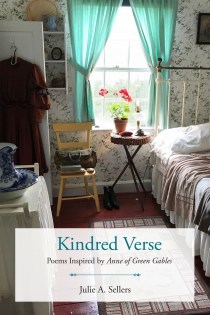
The connection between Anne’s world of a hundred years ago and Julie A. Sellers’ today are beautifully portrayed and invite readers to explore their own connections to Anne’s world and other literary worlds that inspired them and changed their lives. This chapbook is evidence of why we read and an invitation to immerse yourself in Anne’s world and your own world of imagination.
About the AuthorJulie A. Sellers was born and raised in the Flint Hills near the small town of Florence, Kansas. Those great expanses of tallgrass prairie and reading fueled her imagination, and Julie began writing at an early age. After living in several states and countries, Julie is happy to make her home in Atchison, KS, where she teaches Spanish at Benedictine College, and does freelance work as a certified court interpreter.

Julie has published three academic books, and her creative prose and poetry have appeared in publications such as Journal of L.M. Montgomery Studies, 105 Meadowlark Reader, Cagibi, Wanderlust, The Very Edge, and Kansas Time + Place. Julie was the Kansas Author’s Club 2020 Prose Writer of the year. Her collection Kindred Verse: Poems Inspired by Anne of Green Gables (Blue Cedar Press) was released in 2021. You can follow along with Julie on Twitter and Facebook.
If you could visit PEI, where would YOU go first and what would you do?
Grace and peace,
Rachel
Subscribe to my blog
for articles on literature, faith, and my writing adventures!
Order signed books here on my web site!
Each autographed book comes with a matching bookmark.
 The Anne Devotional
The Anne Devotional
 PRE-ORDER THE LITTLE WOMEN DEVO
PRE-ORDER THE LITTLE WOMEN DEVO
 Praying with Jane
Praying with JaneThe post Kindred Verse: Poems Inspired by Anne of Green Gables appeared first on Rachel Dodge.
August 16, 2021
The Roar of Aslan

“Aslan stood up and when he opened his mouth to roar … they saw all the trees in front of him bend before the blast of his roaring as grass bends in a meadow before the wind.”
—The Lion, The Witch And The Wardrobe, C.S. Lewis
This amazing image, “Susan and Aslan” created by artist @panjooolart, caught my eye a few weeks ago. It told a whole story to my heart in a flash. It reminded me of the GREATNESS of God, right beside me, even when I can’t see Him or feel Him.
 “Susan and Aslan” – @panjooolartOur Aslan
“Susan and Aslan” – @panjooolartOur AslanSometimes I need my Aslan, my Jesus, to roar. Don’t you? I especially need Him to beat back my fears and push back the enemy from my gates. To cut through the confusion. To blast through the lies.⠀⠀⠀⠀⠀⠀⠀⠀⠀
C.S. Lewis’ incredible lines, in the above quote from The Lion, The Witch, and The Wardrobe, bring a few different Bible illustrations to mind:
Exodus 15:8: “By the blast of your nostrils the waters piled up. The surging waters stood up like a wall; the deep waters congealed in the heart of the sea.”
And Psalm 18:13-15: “The Lord thundered from heaven; the voice of the Most High resounded. He shot his arrows and scattered the enemy, with great bolts of lightning he routed them. The valleys of the sea were exposed and the foundations of the earth laid bare at your rebuke, Lord, at the blast of breath from your nostrils.”
 The Lion and The Lamb
The Lion and The LambThe Bible uses the metaphors of a lamb and a lion to help us wrap our brains around who Jesus is: He is as gentle as a Lamb and as powerful as a Lion (and then some). I sometimes can’t get over His tender, ferocious love. He is loving and compassionate toward us, His beloved. And yet, He is fierce and loyal and protective.
Sometimes we need to be reminded that Jesus is more powerful than our fears, our enemies, and our doubts. If you need a reminder, here is the next part of Psalm 18:
“He reached down from on high and took hold of me; he drew me out of deep waters. He rescued me from my powerful enemy, from my foes, who were too strong for me. They confronted me in the day of my disaster, but the Lord was my support. He brought me out into a spacious place; he rescued me because he delighted in me.” (Psalm 18:16-19)
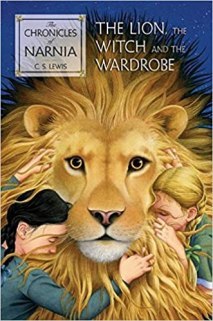 Ever-Present
Ever-PresentWith Jesus by my side, I feel brave. With His help, I’m courageous, excited, motivated, and ready. When I picture Him next to me, guarding me and protecting me, guiding me and supporting me, I go forward with more confidence. I’m sure-footed and agile. My eyes are open. I’m alert and ready to move.
Perhaps you have forgotten that Jesus is by your side. Maybe you need to know that He is FOR YOU. He is walking beside you, watching over you. He is not intimidated or surprised.
Are you up against something difficult? Are you plagued by trials, tribulations, pain, temptation, illness, trepidation, jealousy, or discouragement?
Call out to Jesus, the Lion of Judah, today. Ask Him to come to your rescue. Ask Him to roar.⠀
Grace and peace,
Rachel⠀⠀
If you’d like to read more devotional content like this, check out my Faith blog posts and my Devotional books.⠀
The post The Roar of Aslan appeared first on Rachel Dodge.



